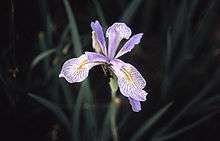Iris ser. Longipetalae
| Long-petaled irises | |
|---|---|
 | |
| Iris missouriensis | |
| Scientific classification | |
| Kingdom: | Plantae |
| (unranked): | Angiosperms |
| (unranked): | Monocots |
| Order: | Asparagales |
| Family: | Iridaceae |
| Genus: | Iris |
| Subgenus: | I. subg. Limniris |
| Series: | I. ser. Longipetalae |
| Species | |
Iris ser. Longipetalae is a series of the genus Iris, in Iris subg. Limniris.
William Rickatson Dykes in his book 'Handbook of Garden Irises' (of 1924) includes 4 species in his Iris longipetala subsection; including Iris longipetala (Herbert), Iris missouriensis Nuttall, Iris arizonica (Dykes, 1917) and Iris montana (Nuttall).[1] Iris arizonica and Iris Montana have since been classified as synonyms of 'Iris missouriensis'.[2]
The series was then first classified as a 'series' by Diels in 'Die Natürlichen Pflanzenfamilien' (Edited by H. G. A. Engler and K. Prantl) in 1930. It was further expanded by Lawrence in Gentes Herb (written in Dutch) in 1953.[3][4]
There is still a lot of confusion within the series.
The British Iris Society only lists Iris missouriensis and classes Iris longipetala as a variant of Iris missouriensis.[5] The American Iris Society and Pacific Iris Society lists three species; Iris longipetala (Herbert), Iris missouriensis (Nuttall) and Iris pariensis (Welsh).[6][7][8] But Plant List regards 'Iris pariensis' as a synonym of 'Iris missouriensis'.[2] 'Iris pariensis' was found by Stanley Larson Welsh in Utah and published in 'Great Basin Naturalist' 46(2): 256 in 1986.[9]
The series has species are native to western North America,[6] seen in Washington (state), Oregon and California.[10]
They prefer to have moisture in the spring and a dry period during the summer. They also do not like root disturbance hence they are difficult to grow as nursery plants. They are also rarely grown in the UK.[10] The species have thick rhizomes,[8] fruiting stems (that follow the flowers) that stay on the plant until the next growing season, (or longer)[6][8] a stigma with 2 teeth (or lobes)[8] and seed capsules with 6 ribs and taper into points on the ends.[6][8]
- Iris longipetala Herbert
- Iris missouriensis Nuttall
References
- ↑ Dykes, William (2009). "Handbook of Garden Irises" (PDF). beardlessiris.org (The Group for Beardless Irises). Retrieved 1 November 2014.
- 1 2 "Iris missouriensis Nutt. is an accepted name". theplantlist.org. 23 February 2012. Retrieved 3 November 2014.
- ↑ James Cullen, Sabina G. Knees, H. Suzanne Cubey (Editors) The European Garden Flora Flowering Plants: A Manual for the Identification, p. 647, at Google Books
- ↑ "Iris ser. Longipetalae (Diels) G.H.M. Lawrence". data.canadensys.net. Retrieved 1 November 2014.
- ↑ Austin, Claire. "Irises A Garden Encyclopedia" (pdf). worldtracker.org. p. 275. Retrieved 1 November 2014.
- 1 2 3 4 "Series Longipetalae (Diels) Lawrence". wiki.irises.org (American Iris Society). 2011-06-16. Retrieved 1 November 2014.
- ↑ "Summary of the Genus Iris" (pdf). pacificbulbsociety.org. Retrieved 1 November 2014.
- 1 2 3 4 5 James Cullen, Sabina G. Knees, H. Suzanne Cubey (Editors) The European Garden Flora Flowering Plants: A Manual for the Identification, p. 254, at Google Books
- ↑ "Iridaceae Iris pariensis S.L.Welsh". ipni.org (International Plant Names Index). Retrieved 3 November 2014.
- 1 2 Stebbings, Geoff (1997). The Gardener's Guide to Growing Irises. Newton Abbot: David and Charles. p. 17. ISBN 0715305395.
External links
 Data related to Iris ser. Longipetalae at Wikispecies
Data related to Iris ser. Longipetalae at Wikispecies Media related to Iris ser. Longipetalae at Wikimedia Commons
Media related to Iris ser. Longipetalae at Wikimedia Commons